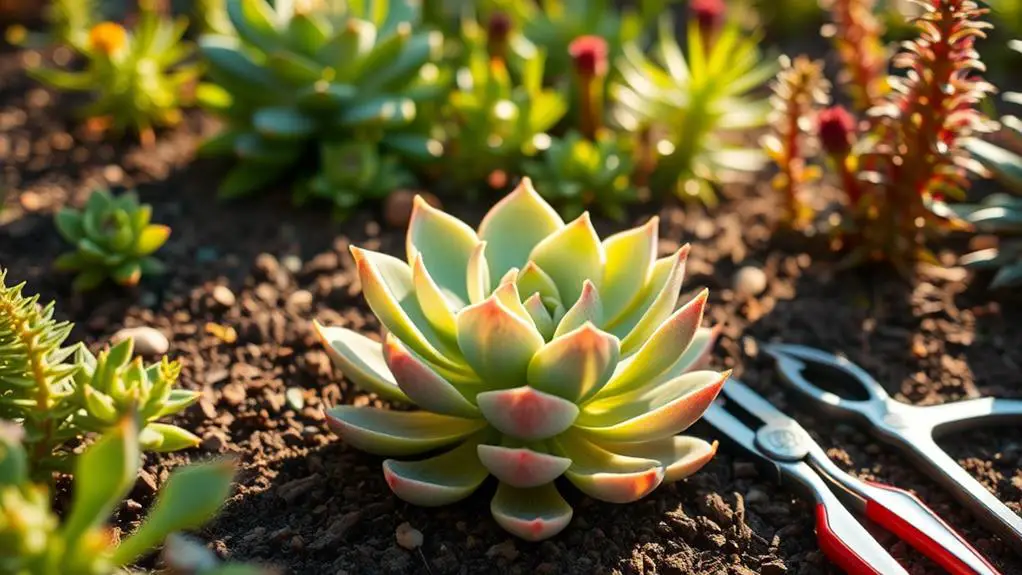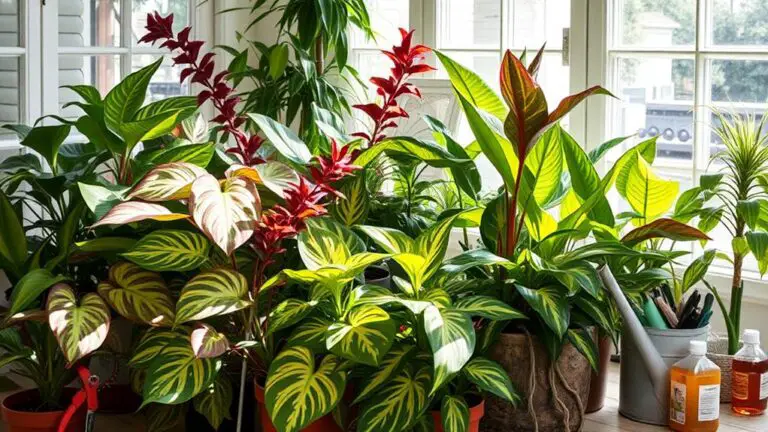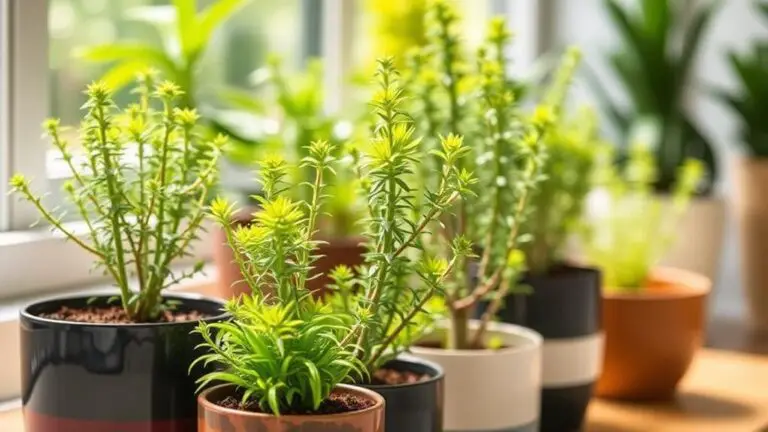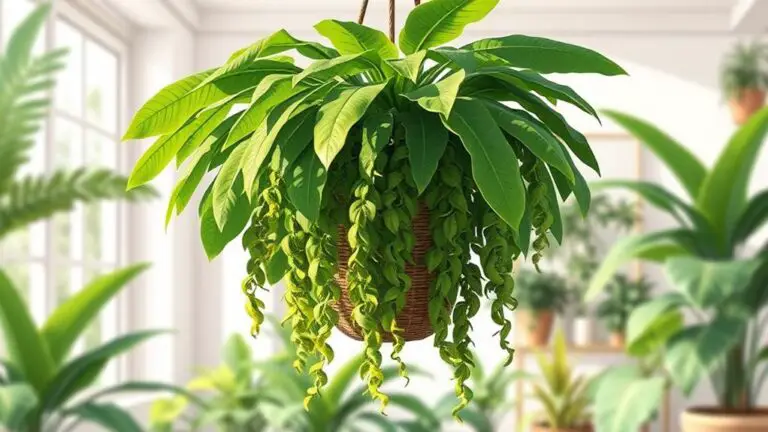10 Simple Steps to Care for Your Echeveria Afterglow
Caring for your Echeveria Afterglow doesn't have to be complicated if you follow a few straightforward steps. Start by choosing a bright spot where it gets at least six hours of direct sunlight daily. Next, make sure to use a well-draining cactus mix to prevent root rot. You'll need to water it sparingly, allowing the soil to dry out completely between watering sessions. Routine maintenance like pruning dead leaves and checking for pests will keep your plant healthy. But there's more to ensuring this succulent thrives, and you might be surprised by how simple it can be.
Choose the Right Location
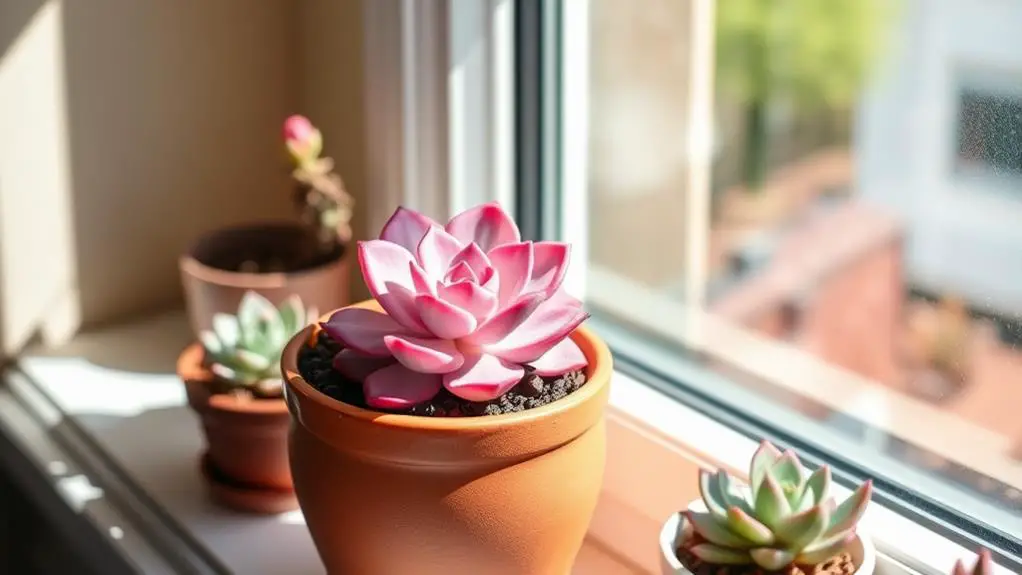
To guarantee your Echeveria Afterglow thrives, choosing the right location is essential. This beautiful succulent loves bright, direct sunlight. It needs at least six hours of light daily to grow well and keep its vibrant color.
If you're keeping it indoors, place it near a south or west-facing window. These spots get the most natural light throughout the day, which your plant will appreciate.
When planting outdoors, you should be in USDA Hardiness Zones 9a-11b. These zones have temperatures that stay above 30°F, which keeps your Echeveria safe from cold damage.
However, be careful with harsh afternoon sun. Too much intense light can scorch the leaves. So, aim for a spot that gets plenty of morning light but has some shade in the afternoon.
Good drainage is also important. Whether indoors or outdoors, make sure your pot has drainage holes. This prevents water from sitting in the soil, which can cause root rot.
You might also consider using a well-draining soil mix designed for succulents. To summarize, find a sunny spot with some afternoon shade and guarantee proper drainage to keep your Echeveria Afterglow healthy and happy.
Ensure Proper Sunlight
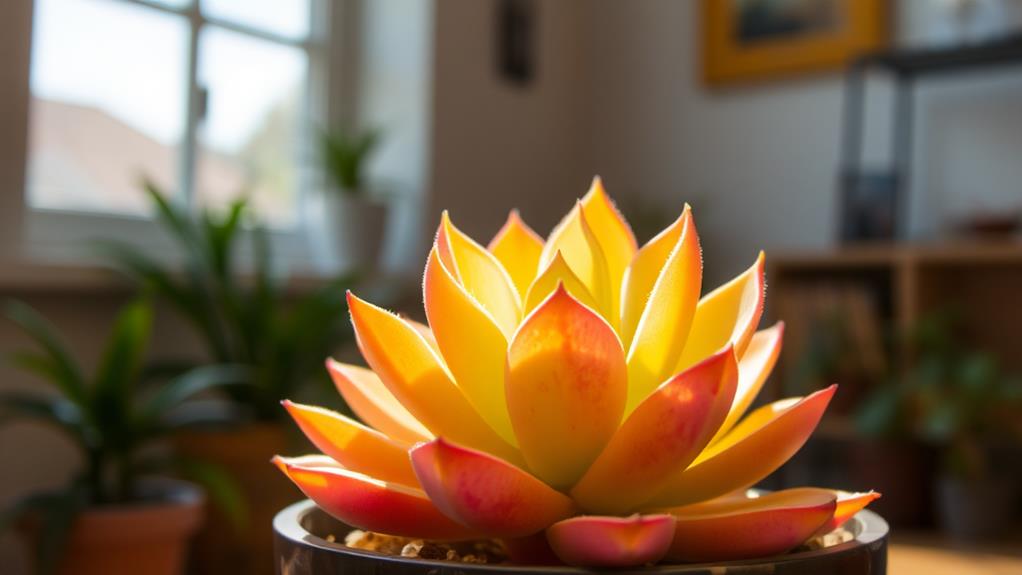
Choosing the right location sets the stage, but ensuring your Echeveria Afterglow gets proper sunlight is the next essential step. This plant needs at least 6 hours of direct sunlight daily to thrive and maintain its vibrant colors. Placing it near a south or west-facing sunny window is ideal for ideal light exposure indoors.
If your Echeveria Afterglow doesn't get enough light, it can become leggy and lose its beautiful color. While it can tolerate partial shade, too much shade isn't good for it. If natural light is insufficient, especially during winter, consider using artificial grow lights to supplement sunlight.
Remember, though, to protect the plant from harsh afternoon sun to prevent leaf scorching, particularly in very hot climates.
To help your Echeveria Afterglow thrive, here are some tips:
- Place it near a south or west-facing window for the right amount of light.
- Use artificial grow lights if natural light is limited.
- Watch out for leaf scorching and move it if the sun is too intense.
Ensuring proper drainage is also essential, but we'll cover that in the next section. For now, focus on providing the right amount of light to keep your Echeveria Afterglow happy and healthy.
Use Well-Draining Soil
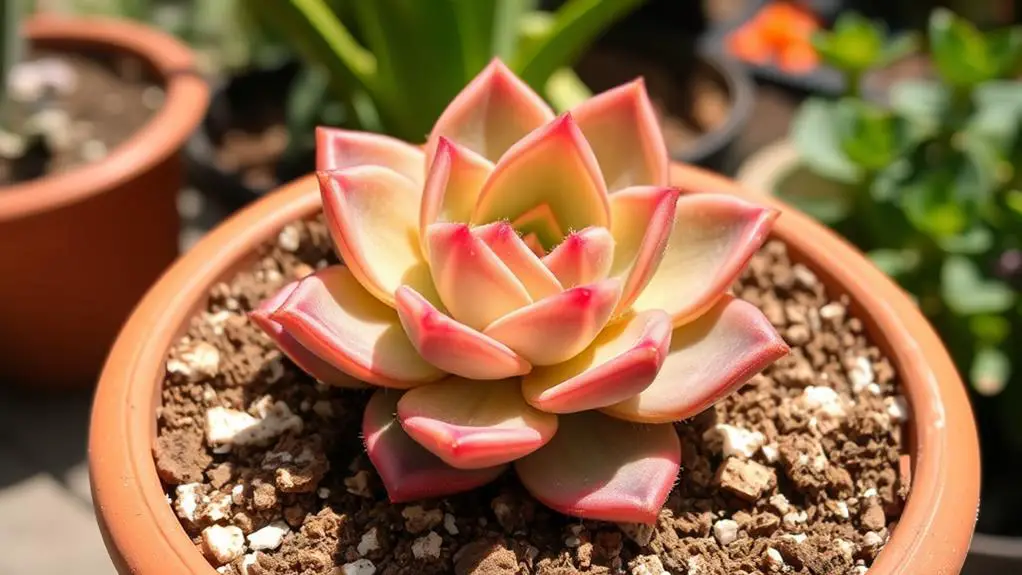
When it comes to guaranteeing the health of your Echeveria Afterglow, using well-draining soil is fundamental. This type of soil is essential to prevent root rot, a common issue caused by excess moisture. To create the perfect environment for your plant, opt for a cactus and succulent mix. This mix allows water to pass through quickly, keeping the roots dry and healthy.
An ideal well-draining soil contains 50%-70% mineral grit, such as perlite or pumice. These materials enhance drainage and improve aeration, which is critical for a healthy Echeveria Afterglow.
| Soil Component | Purpose |
|---|---|
| Cactus mix | Base |
| Perlite | Drainage |
| Pumice | Aeration |
| Sand | Texture |
| Organic matter | Nutrients |
Additionally, aim for a soil pH between 6.0 and 7.0. This range guarantees the soil is neither too acidic nor too alkaline, promoting peak growth. Regularly check for compacted soil, as it can impede drainage and cause water to accumulate around the roots. To maintain the soil's effectiveness, consider repotting your Echeveria Afterglow every 2-3 years. Fresh soil will refresh nutrients and keep your plant thriving.
Water Sparingly
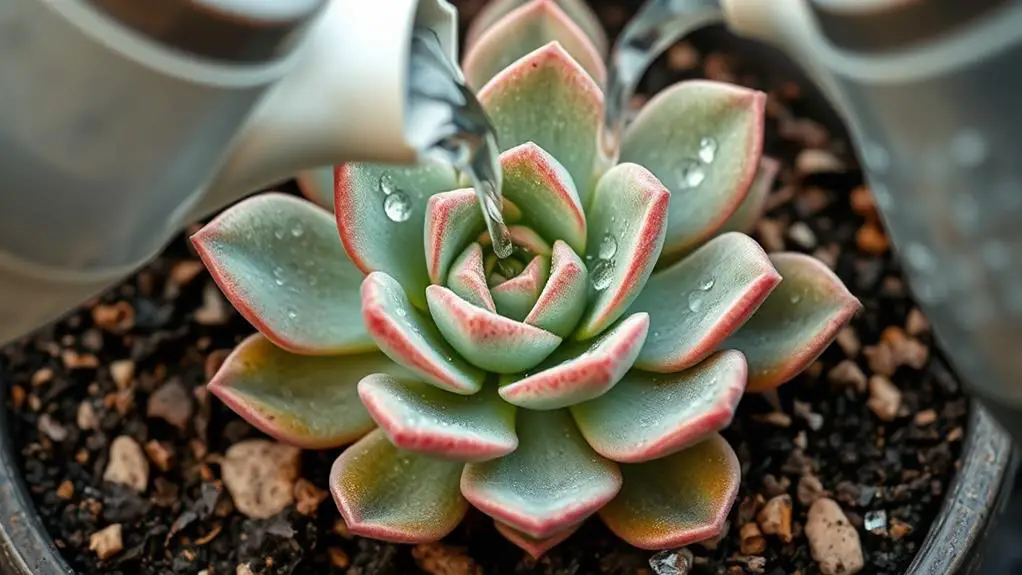
Watering your Echeveria Afterglow sparingly is essential for its health.
Always check if the soil is completely dry before giving it a good soak, and make sure your pot has drainage holes to prevent water from building up.
Soil Drainage Importance
Proper soil drainage is vital for the health of your Echeveria Afterglow. When you use a well-draining soil mix, like a cactus mix, you prevent water accumulation that can lead to root rot. The soil should dry out completely between watering sessions, following the "soak and dry" method. This approach involves thoroughly soaking the soil and then letting it dry out before watering again.
Make certain your pots have drainage holes. These holes let excess water escape, maintaining ideal soil moisture and preventing fungal infections. Overwatering can cause yellow, mushy leaves, while infrequent watering encourages vibrant colors and healthy growth.
To help you enjoy caring for your Echeveria Afterglow, remember to:
- Use a cactus soil mix: Guarantees proper drainage and avoids water accumulation.
- Choose pots with drainage holes: Allows water to escape, preventing root rot.
- Follow the "soak and dry" method: Promotes a healthy watering routine.
With these tips, you'll keep your Echeveria Afterglow thriving and beautiful. Proper soil drainage is essential to avoid problems and guarantee your plant stays happy and healthy.
Keep an eye on your plant, and you'll be rewarded with stunning, vibrant succulents.
Monitor Moisture Levels
Keeping an eye on moisture levels is essential for the health of your Echeveria Afterglow. These beautiful succulents require infrequent watering, so it's important to let the soil dry out completely between sessions. By doing so, you can prevent root rot, which is a common issue caused by excessive moisture.
Use the "soak and dry" method to water your Echeveria Afterglow. This involves giving the soil a thorough soaking and then allowing it to dry out entirely before watering again. Make sure your pot has drainage holes to avoid water accumulation at the bottom. Overwatering can lead to yellow, mushy leaves, while not watering enough results in dry, crispy leaves.
Regularly monitor the moisture levels by checking the top inch of soil. If it feels dry, it's time to water. Environmental conditions also play a role in how often you should water. During hot summer months, your plant may need more frequent watering. Conversely, in cooler months, you can water less often.
For best results, always check the bottom of the pot for moisture before deciding to water. By carefully monitoring and adjusting your watering routine, you'll keep your Echeveria Afterglow thriving.
Monitor Soil Moisture
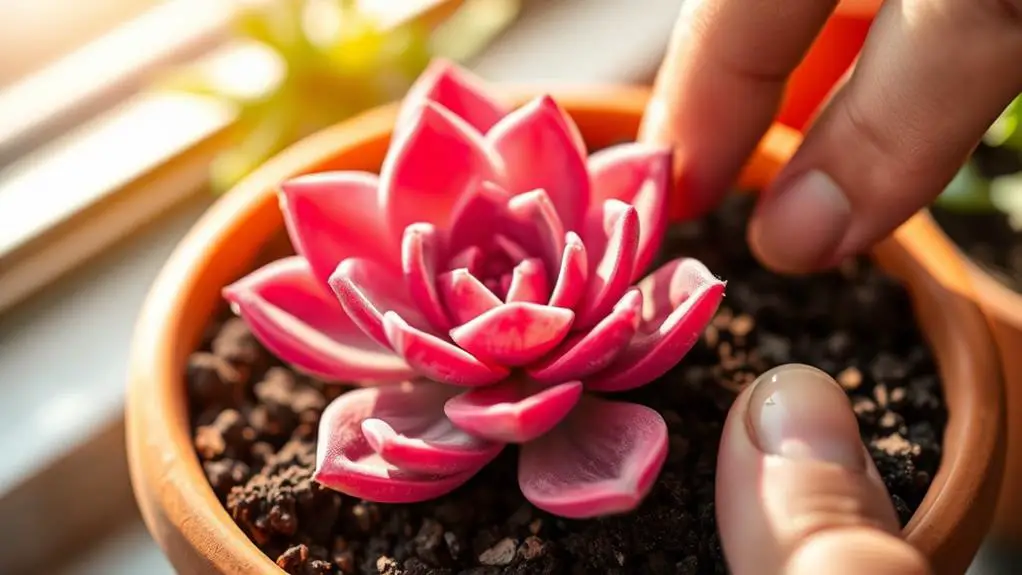
To keep your Echeveria Afterglow healthy, it's important to monitor soil moisture carefully.
Use the "soak and dry" method and check the top 1-2 inches of soil; if it feels dry, it's time to water.
This helps prevent root rot and keeps your plant thriving.
Ideal Watering Frequency
Monitoring soil moisture is essential to determining the ideal watering frequency for your Echeveria Afterglow. These succulents need infrequent watering, so let the soil dry out completely between sessions to prevent overwatering.
Typically, watering every 2-3 weeks during the growing season works well, but you may need to adjust based on your local environment and humidity levels.
To check soil moisture, insert your finger about an inch deep into the soil. If it feels dry, it's time to water. Use the "soak and dry" method: thoroughly water the plant, making sure excess water drains out of the pot. This helps avoid overwatering, which can cause yellow, mushy leaves.
On the other hand, underwatering results in dry, crispy leaves. Regular monitoring is vital for keeping your plant healthy.
Here are some tips to help you:
- Check soil moisture regularly: Insert your finger about an inch deep to feel for dryness.
- Adapt to environmental conditions: Adjust watering frequency based on temperature and humidity.
- Use the "soak and dry" method: Thoroughly water and make sure excess drains away.
Preventing Root Rot
Root rot is a common issue for Echeveria Afterglow, primarily caused by overwatering and poor drainage. Preventing root rot starts with monitoring soil moisture closely. Use the "soak and dry" method to water your plant. This means you thoroughly soak the soil and then let it dry out completely before the next watering session. Regularly check that the top 1-2 inches of soil are dry before rewatering. This simple step can prevent conditions that lead to root rot.
Using a well-draining cactus and succulent mix is essential. It enhances drainage and reduces water buildup around roots. Also, verify your pot has drainage holes to let excess water escape. Overwatering can make leaves yellow and mushy, a clear sign that it's time to adjust your watering frequency. Environmental conditions like humidity and temperature can affect how often you need to water, so always keep an eye on these factors.
Here's a quick table to guide you:
| Step | Action |
|---|---|
| Soil Check | Verify top 1-2 inches are dry |
| Watering Method | Use "soak and dry" technique |
| Soil Type | Use well-draining cactus mix |
| Pot Requirement | Verify pots have drainage holes |
Fertilize During Growth

Although Echeveria Afterglow doesn't typically need fertilization, providing a balanced water-soluble fertilizer during its spring and summer growing season can considerably promote its growth. This succulent thrives with an extra nutrient boost during these active months, guaranteeing it maintains vibrant and healthy leaves.
To fertilize your Echeveria Afterglow correctly, use a balanced water-soluble fertilizer specifically formulated for succulents. Dilute the fertilizer to half strength to prevent over-fertilization, which could harm the plant.
Apply the diluted fertilizer every 4-6 weeks during the growing season. This schedule provides the plant with essential nutrients without overwhelming it.
Remember, it's essential to avoid fertilizing during the dormant winter months. During this time, the plant's growth slows, and it requires minimal nutrients. Over-fertilizing in winter can lead to root damage and other issues.
Here are some simple tips to help you succeed:
- Use a succulent-specific fertilizer: Guarantees the plant gets the right nutrients.
- Dilute to half strength: Prevents over-fertilization and potential harm.
- Fertilize every 4-6 weeks: Keeps the plant nourished without overwhelming it.
Prune Dead Leaves
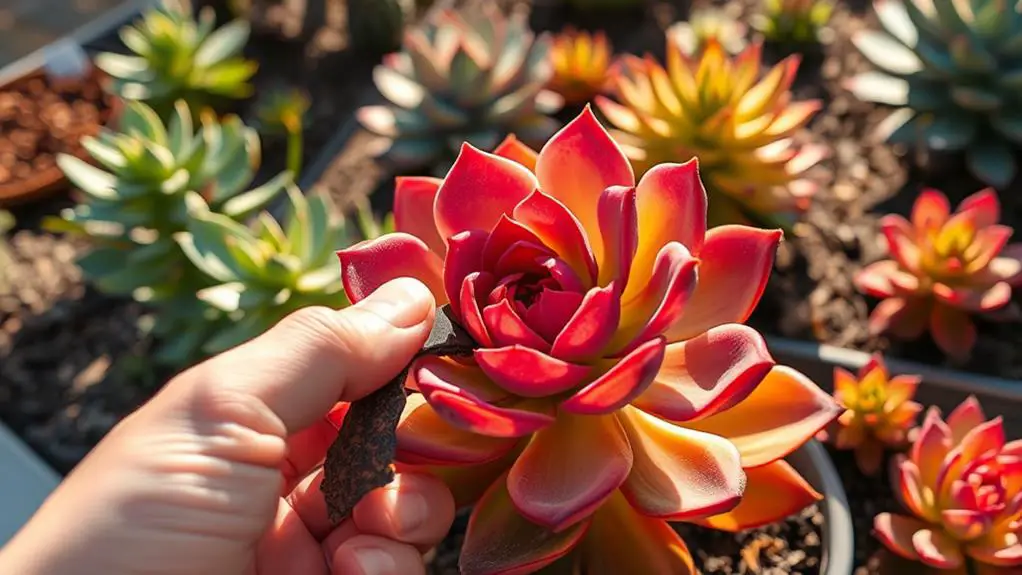
Pruning dead leaves from your Echeveria Afterglow is crucial for maintaining its appearance and overall health. By removing these leaves, you help prevent pest infestations and promote better airflow around the plant. This can reduce the risk of fungal infections, keeping your Echeveria vibrant and thriving.
To prune dead leaves, use clean, sharp scissors or pruning shears. This minimizes the stress on the plant and guarantees a clean cut. Inspect your Echeveria regularly for any leaves that look discolored, wilting, or mushy. These signs could indicate overwatering or disease. Removing these leaves promptly helps the plant stay healthy and redirects its energy to new growth.
Pruning is typically not necessary for Echeveria Afterglow, but when you do it, aim for the growing season in spring or early summer. This timing allows the plant to recover quickly and benefit from the increased sunlight and warmth.
Gently cut the dead or damaged leaves at their base, being careful not to harm the healthy parts of the plant.
Repot Every Few Years
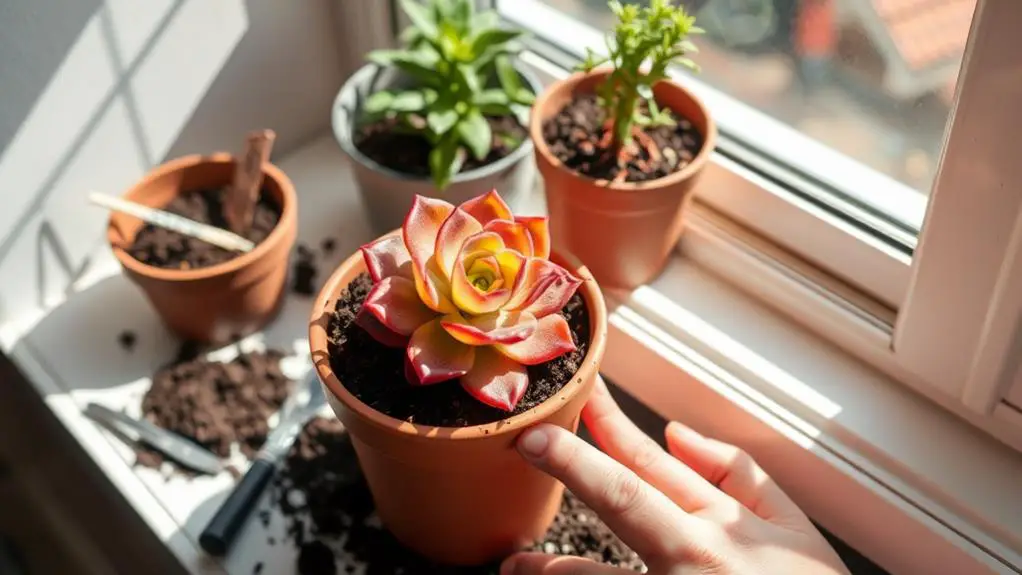
Repotting your Echeveria Afterglow every 2-3 years during the growing season refreshes the soil, giving your plant the nutrients it needs for healthy growth.
Choose a pot that's just one size bigger to give the roots more space without causing too much moisture.
Make sure to use a well-draining mix and check the roots, trimming any damaged ones to keep your plant thriving.
Soil Refreshment Benefits
Revitalizing the soil of your Echeveria Afterglow every 2-3 years is essential for maintaining its health and ensuring ideal growth. Repotting not only refreshes the soil but also provides your plant with crucial nutrients and better drainage. This process helps remove any accumulated salts and toxins, promoting healthier root development and overall vitality.
When you repot, be sure to use a well-draining cactus mix. This type of soil mimics the arid conditions Echeveria Afterglow thrives in, preventing root rot and other moisture-related issues. Choose a new pot that's just one size larger than the current one. This prevents excess moisture retention, which can harm your plant.
Repotting can also encourage the formation of offsets, which are small plants that grow from the base of the main plant. These offsets can be left to grow, enhancing the plant's appearance, or they can be propagated to create new plants.
- Refresh the soil: Removes salts and toxins for healthier roots.
- Use well-draining cactus mix: Prevents root rot and mimics natural conditions.
- Encourages offsets: Enhances beauty and allows for propagation.
Growth Space Optimization
Guaranteeing your Echeveria Afterglow has adequate space to grow is critical for its health and longevity. Repotting your plant every 2-3 years helps refresh the soil and guarantees proper drainage, preventing root rot.
When you notice roots growing out of the drainage holes or the plant becoming root-bound, it's time to repot.
Choose a pot that's only one size larger than the current one. Going too big can lead to excess soil, which retains moisture and may cause overwatering.
Use a well-draining cactus and succulent mix, ideally with 50%-70% mineral grit. This mix supports your Echeveria's growth and health by allowing water to flow through easily, preventing soggy roots.
Repotting during the spring or summer growing season is best. During this time, your plant is most active and can recover from any transplant shock more effectively.
Carefully remove the plant from its old pot, shake off excess soil, and inspect the roots. Trim any dead or rotting roots before placing it in fresh soil.
Check for Pests
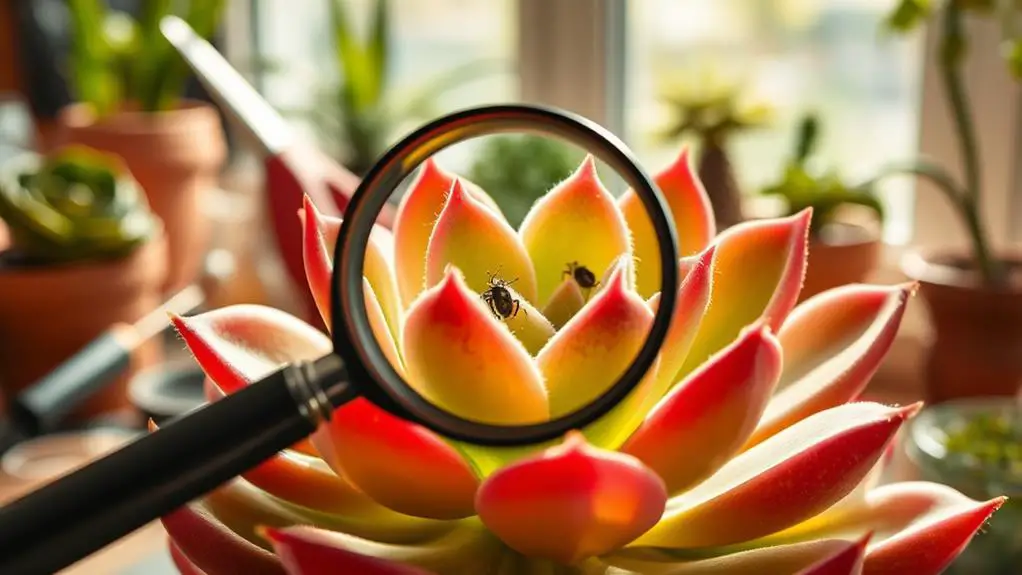
When caring for your Echeveria Afterglow, regularly inspecting for pests is essential to maintaining the plant's health. Common pests like mealybugs and aphids can cause significant damage if left untreated.
Mealybugs often appear as white, cotton-like masses on the leaves, while aphids are small green or black insects found on stems and leaves. Spotting these early can make treatment much easier.
To treat infestations, use insecticidal soap or neem oil, applying it according to the product instructions. These treatments are effective and safe for your Echeveria Afterglow.
Additionally, maintaining good air circulation around your plant helps reduce the likelihood of pests and prevents fungal diseases caused by excess moisture.
Keep an eye out for signs of stress such as yellowing or wilting leaves, as these may indicate underlying pest issues that need immediate attention.
By staying vigilant and taking action at the first sign of trouble, you can keep your Echeveria Afterglow thriving.
- Inspect your plant regularly for mealybugs and aphids.
- Use insecticidal soap or neem oil for safe, effective treatment.
- Maintain good air circulation to prevent pest infestations.
Propagate New Plants
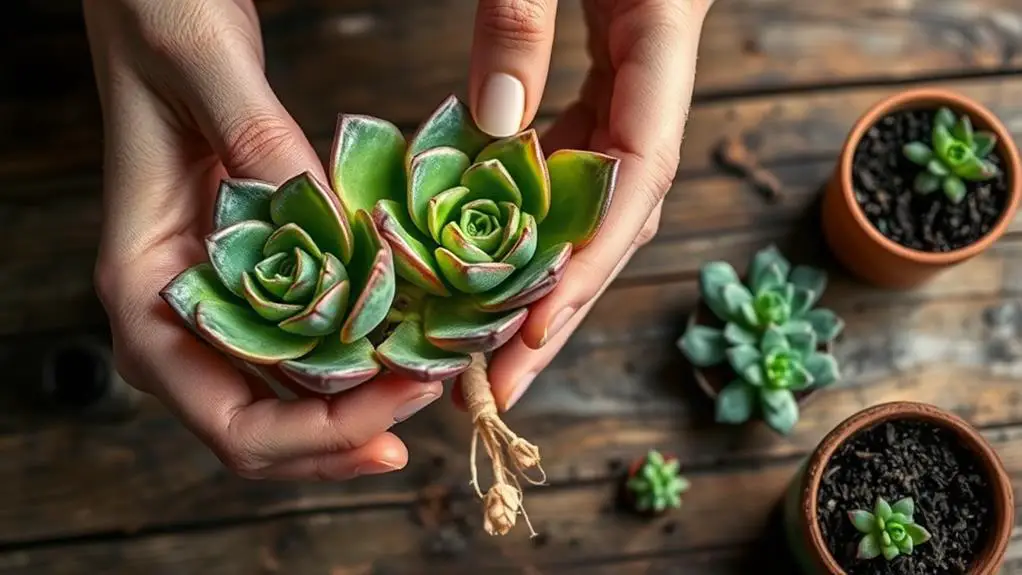
After ensuring your Echeveria Afterglow is pest-free, you might be interested in expanding your collection through propagation. You can easily propagate new plants from either leaf cuttings or offsets.
To start with leaf cuttings, gently remove a healthy leaf from your Echeveria Afterglow. Let the leaf dry and callous for 1-2 days. Once it's ready, place the leaf on well-draining soil. A cactus and succulent mix works best. Make sure the soil is dry to avoid rot. Over time, roots will develop, and a new plant will start to grow.
Offsets, also known as "chicks," form around the base of the mother plant. When these offsets are a few inches tall, carefully separate them from the parent plant. Handle them gently to avoid damage. Replant the offsets in well-draining soil, similar to what you'd use for the leaf cuttings.
For successful propagation, keep your new plants in a warm environment with bright, indirect light. Water sparingly until the roots are established. This might take some patience, but soon, you'll have thriving new Echeveria Afterglow plants.
With some care and attention, you can enjoy a growing collection of these beautiful succulents!
Frequently Asked Questions
How to Take Care of Echeveria Afterglow?
Place your Echeveria Afterglow near a south or west-facing window for sunlight. Water infrequently with the "soak and dry" method. Fertilize sparingly, repot every 2-3 years, and check for pests regularly.
How Do You Care for Echeveria Orion Succulents?
To care for your Echeveria Orion, place it in bright, direct sunlight for 6 hours daily. Use well-draining soil, water every 1-2 weeks, fertilize in spring and summer, monitor for pests, and repot every 2-3 years.
Why Are the Leaves Falling off My Echeveria Afterglow?
Your Echeveria Afterglow's leaves fall off due to overwatering, underwatering, insufficient light, pests, or environmental stress. Guarantee proper watering, adequate sunlight, pest control, and stable temperature to keep your plant healthy and prevent leaf drop.
How Do You Care for Echeveria Indoors?
To care for your Echeveria indoors, place it near a south or west-facing window for sunlight, use well-draining soil, water infrequently, maintain 30%-40% humidity, and inspect regularly for pests. Proper care guarantees vibrant growth.
Conclusion
Caring for your Echeveria Afterglow is easy if you follow these steps. Just remember to give it plenty of sunlight, water it sparingly, and use well-draining soil. Don't forget to prune dead leaves and check for pests regularly. Repotting every few years and propagating new plants will keep your succulent thriving. With a little attention and care, your Echeveria Afterglow will flourish. You've got this, and your plant will thank you!

